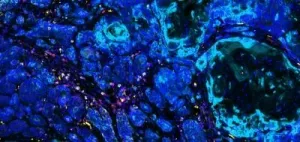Stronger together: how protein filaments interact
University of Göttingen research team investigate microtubules
2021-06-18
(Press-News.org) Just as the skeleton and muscles move the human body and hold its shape, all the cells of the body are stabilised and moved by a cellular skeleton. Unlike our skeleton, this cellular skeleton is a very dynamic structure, constantly changing and renewing itself. It consists of different types of protein filaments, which include intermediate filaments and microtubules. Now, a research team from the University of Göttingen is the first to succeed in observing a direct interaction between microtubules and intermediate filaments outside the cell, and also in quantitatively measuring this interaction. The results of the study were published in Nature Communications.
Microtubules are dynamic filaments that constantly grow and shrink again and, in this way, are responsible for many important processes in cells. The research team observed that intermediate filaments stabilise microtubules: when intermediate filaments are added to microtubules, shrinkage is suppressed and thus the lifespan of the microtubules is extended. To investigate whether this is actually due to direct interactions between the two filaments, a single microtubule was positioned crossed with a single intermediate filament.
Dr Laura Schaedel, who shares first authorship of the publication with Charlotta Lorenz (PhD student at the Institute for X-ray Physics at the University of Göttingen), explains: "The intermediate filament was 'pulled' over the microtubule like a bow over a violin string." Lorenz adds, "This allows the two filaments to bind to each other. However, this bond is broken again shortly afterwards due to the pulling. The process of 'tearing apart' provides information about the strength of the bond." Professor Stefan Klumpp from the Institute for the Dynamics of Complex Systems at Göttingen University, who led the project together with Professor Sarah Köster from the Institute for X-ray Physics, says, "In addition, we used models and simulations to show that the direct interaction leads to stabilisation." The stabilisation of dynamic microtubules can be an important issue for biological cells, for example to regulate their local stability. "The interactions that we observed are important because they enable better understanding of cellular processes," says Köster.
These results are in turn relevant for understanding many other processes, such as those involved in diseased cells. The new method to take direct measurements of the actual interaction of two different biopolymers can also be applied to other protein filaments, as well as to non-biological fibres.
INFORMATION:
Original publication: Laura Schaedel*, Charlotta Lorenz*, Anna V. Schepers, Stefan Klumpp#, and Sarah Köster#: Vimentin Intermediate Filaments Stabilize Dynamic Microtubules by Direct Interactions, Nat. Commun. 2021. Doi: 10.1038/s41467-021-23523-z . Text also available here: https://www.nature.com/articles/s41467-021-23523-z
(*equal contribution; #corresponding author)
Contact:
Professor Sarah Köster
University of Göttingen
Institute for X-ray Physics
Friedrich-Hund-Platz 1, 37077 Göttingen, Germany
Tel: +49 (0)551/3929429
Email: sarah.koester@phys.uni-goettingen.de
http://www.uni-goettingen.de/koesterlab
Professor Stefan Klumpp
University of Göttingen
Institute for the Dynamics of Complex Systems
Friedrich-Hund-Platz 1, 37077 Göttingen, Germany
Tel: +49 (0)551/3926942
Email: stefan.klumpp@phys.uni-goettingen.de
https://www.uni-goettingen.de/de/527801.html
ELSE PRESS RELEASES FROM THIS DATE:
2021-06-18
Study Highlights
New research reveals how key proteins interact to regulate the body's response to stress
Targeting these proteins may help treat or prevent stress-related psychiatric disorders
The biological mechanisms behind stress-related psychiatric conditions, including major depressive disorder and post-traumatic stress disorder (PTSD), are poorly understood.
New research now details the interplay between proteins involved in controlling the body's stress response and points to potential therapeutic targets when this response goes awry. The study, which was conducted by an international team led by investigators at McLean Hospital, appears in ...
2021-06-18
BOSTON - Researchers from Massachusetts General Hospital (MGH) have discovered a biological mechanism that transforms cells exposed to carcinogens from environmental factors like smoking and ultraviolet light into immunogenic cells that can be harnessed therapeutically to fight treatment-resistant cancers. As reported in Science Advances, that mechanism involves spurring the release of small proteins known as chemokines which, in turn, recruit antitumor immune cells (CD8+ T cells) to the tumor site to block metastasis, potentially enhancing the effectiveness of a new generation of immunotherapies.
"Immunotherapeutics ...
2021-06-18
CHICAGO --- Scientists have long known the brain's hippocampus is crucial for long-term memory. Now a new Northwestern Medicine study has found the hippocampus also plays a role in short-term memory and helps guide decision-making.
The findings shed light on how the hippocampus contributes to memory and exploration, potentially leading to therapies that restore hippocampal function, which is impacted in memory-related aging and neurodegenerative diseases such as dementia, the study authors said.
In the study, scientists monitored participants' brain activity and tracked their eye movements while looking at different complex pictures. The scientists discovered ...
2021-06-18
Birds build nests to keep eggs and baby nestlings warm during cool weather, but also make adjustments in nest insulation in such a way the little ones can keep cool in very hot conditions. Mammals, such as rabbits or groundhogs, sleep or hibernate in underground burrows that provide stable, moderate temperatures and avoid above-ground conditions that often are far more extreme outside the burrow.
Michael Dillon, an associate professor in the University of Wyoming Department of Zoology and Physiology, was part of a research group that examined animals' ability to respond to climate change likely depends on how well they modify their habitats, ...
2021-06-18
BIRMINGHAM, Ala. - A comprehensive health-screening program in rural northern KwaZulu-Natal, South Africa, has found a high burden of undiagnosed or poorly controlled non-communicable diseases, according to a study published in The Lancet Global Health.
Researchers found that four out of five women over the age of 30 were living with a chronic health condition, and that the HIV-negative population and older people -- especially those over 50 -- bore the higher burden of undiagnosed or poorly controlled non-communicable diseases such as diabetes and hypertension.
The study was co-led by Emily Wong, M.D., a resident faculty member at the Africa Health ...
2021-06-18
Irvine, CA - June 18, 2021 - A new study paves the way for the development of next generation therapeutics for the prevention and treatment of Clostridioides difficile infection (CDI), the most frequent cause of healthcare-acquired gastrointestinal infections and death in developed countries.
Published today in Nature Communications, the study reveals the first 3D structure of the Clostridioides difficile toxin B (TcdB) in complex with chondroitin sulfate proteoglycan 4 (CSPG4), a human receptor. The study was co-led by senior author Rongsheng Jin, PhD, a professor in the Department of Physiology & Biophysics at the University of California, Irvine, School of Medicine, and Min Dong, PhD, an associate professor at Harvard Medical School.
"TcdB is one of two homologous C. ...
2021-06-18
June 18, 2021 - An experimental artificial heart includes an autoregulation control mechanism, or Auto-Mode, that can adjust to the changing needs of patients treated for end-stage heart failure. Outcomes in the first series of patients managed with the new heart replacement pump in Auto-Mode are presented in the ASAIO Journal, official journal of the American Society for Artificial Internal Organs. The journal is published in the Lippincott portfolio by Wolters Kluwer.
The study reports on the response to "pressure sensor-based autoregulation of blood flow" in ten patients for up to two years after implantation of the Carmat Total Artificial ...
2021-06-18
The visual thalamus is classically known to relay visual stimuli coming from the retina to the cerebral cortex. Researchers from the Max Planck Institute of Neurobiology now show that although neurons in the mouse visual thalamus connect to both eyes, they establish strong functional connections only with one retina. These results settle partly contradictory results of earlier studies and demonstrate how important it can be to complement structural data with functional analyses.
We have two eyes, but perceive the tree in front of us only once. Our brain therefore has the complicated task of combining the information of both eyes in a meaningful way. To do so, visual stimuli first travel from the retina via so-called ganglion cells to the visual thalamus. There, the information does end up ...
2021-06-18
June 18, 2021 - At least so far, the currently limited research base does not establish that cannabis has additional adverse effects on brain development or functioning in adolescents or young adults with attention-deficit/hyperactivity disorder (ADHD), concludes a review in the July/August issue of Harvard Review of Psychiatry. The journal is published in the Lippincott portfolio by Wolters Kluwer.
While ADHD is clinically defined to have impairments in cognitive functioning, cannabis use by itself is also associated with cognitive impairments: "[T]he evidence to date does not clearly support either an addictive effect or an interaction - whether protective ...
2021-06-18
After graduating or leaving college, many students face a difficult choice: Try to pay off their student loans as fast as possible to save on interest, or enroll in an income-based repayment plan, which offers affordable payments based on their income and forgives any balance remaining after 20 or 25 years.
There are pros and cons to each option, and trying to discern the better path can be daunting. That's why University of Colorado Boulder's Yu-Jui Huang and Saeed Khalili, a former graduate student in financial mathematics, along with Dublin City University's Paolo Guasoni, decided to throw a little mathematical ...
LAST 30 PRESS RELEASES:
[Press-News.org] Stronger together: how protein filaments interact
University of Göttingen research team investigate microtubules





